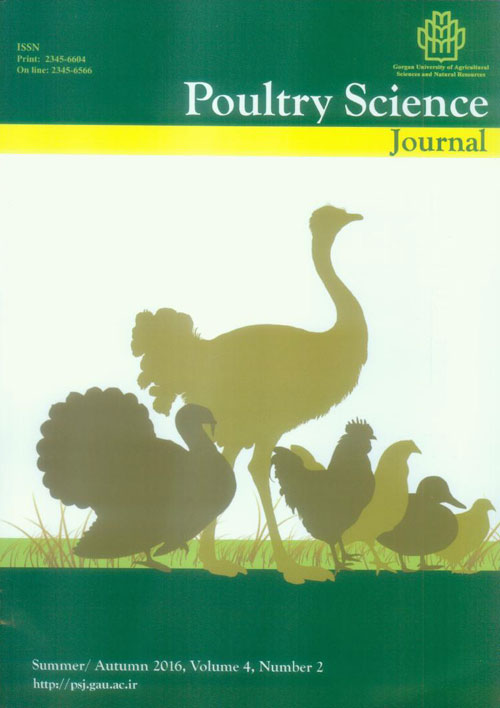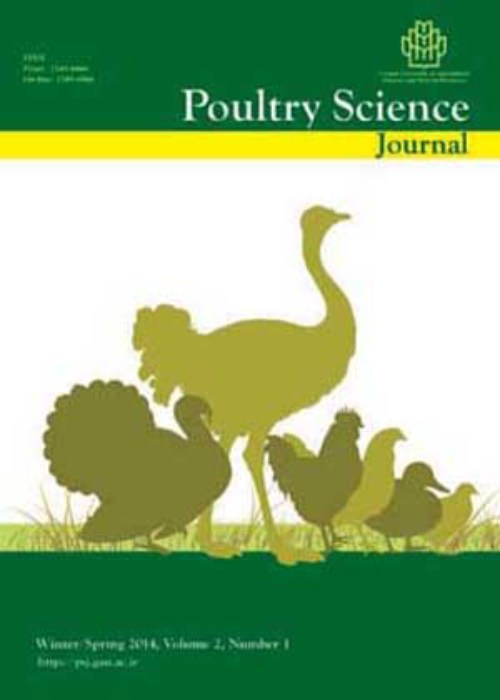فهرست مطالب

Poultry Science Journal
Volume:4 Issue: 2, Summer-Autumn 2016
- 110 صفحه،
- تاریخ انتشار: 1395/11/10
- تعداد عناوین: 10
-
-
Page 81This study evaluated the effect of the intermittent light program on serum and brain melatonin concentrations, antioxidant enzyme activities, and homocysteine concentration in broiler chickens. A total of 60 one-day-old broiler chickens (Cobb 500) were distributed in three light-proof controlled rooms (20 chicks per room). All birds were reared in continuous light until 3 days of age. Then, chicks were treated as follows: 1) intermittent lighting program (1L: 3D cycles), 2) continuous lighting program (24L), and 3) nonintermittent restricted lighting program (8L: 16D). At day 42 of age, sera and brains were collected from all chicks of each group (at the end of the dark phase for groups 1 and 3). Serum and brain melatonin concentrations were not affected by the different photoperiod schedules. Serum glutathione reductase, glucose-6-phosphate dehydrogenase, superoxide dismutase, and glutathione peroxidase activity as well as homocysteine concentration were also similar between different treatment groups. In conclusion, intermittent lighting program during the rearing period does not affect serum and brain melatonin levels as well as antioxidant status at the end of the dark phase in broilers.Keywords: Broiler, Melatonin, Lighting program, Antioxidant enzyme activity
-
Page 89The aim of this study was to recognize the effects of dietary hempseed (HS) and hempseed oil (HO) on performance, egg quality and blood parameters of laying hens. A total of 320 Hy-line 55-weeks laying hens were randomly allotted to eight dietary treatments with five replicates (8 birds each). The experimental treatments were offered as a completely randomized design as follow: control group (no addition), four levels of HS (5, 10, 15, 20%), and three levels of HO (2, 4, 6%) added to the basic diet. The trial was performed for 12 weeks (3 four-weeks periods) started at the age 55 wk. Eggs were daily collected and weighed. Results showed that the highest egg production, egg mass and the lowest feed intake and feed conversion ratio were observed in birds fed 6% HO in diet (PKeywords: Laying hen, Egg quality, Performance, Hempseed oil, Blood parameter
-
Page 97The objective of the study was to compare the effects of antibiotic virginiamycin, probiotic Protexin® and Plantago major L. (plantain) on performance, serum metabolites, immune response, and the ileal microbial population of broilers. The experiment was carried out with a total of 200 day-old male Ross 308 broiler chickens in a completely randomized design. Chickens were allocated to five groups consisting of T1: control diet (Con), T2: Con.02% virginiamycin, T3: Con.01% Protexin, T4: Con.5% plantain and T5: Con% plantain. Each group was divided into four replicates consisting of ten chicks each. In comparison with the control group, body weight gain increased in chickens fed Protexin and 0.5% plantain groups in the starter period, as well as by antibiotic in grower and finisher periods and by 1% plantain in all periods (PKeywords: Broiler, Probiotic, Antibiotic, Plantago major, Growth Performance
-
Page 107In this experiment, the effects of fennel and thyme extracts with and without flaxseed were investigated on performance and egg quality of Leghorn-type laying hens (Hy-Line W-36). 200 laying hens from 26 to 38 weeks of age were assigned to five dietary treatments with five replications. The treatment groups were: 1) Control (a diet without any additives); 2) control diet plus fennel (40 mg/kg feed); 3) control diet plus thyme (40 mg/kg feed); 4) a diet containing flaxseed and fennel; and 5) a diet containing flaxseed plus thyme. There were significant differences in feed intake and egg weight between the treatments (PKeywords: Fennel, Thyme, Laying hen, Egg quality, Herbal extract
-
Page 117The aim of this study was to investigate the effects of dietary garlic on the growth performance, intestinal mucosa morphology, and pulmonary hypertensive response in broiler chickens with pulmonary hypertension induced by 3, 5, 3′-l triiodothyronine. Chicks were reared for 42 days and treated with triiodothyronine (1.5 mg/kg diet) and 0 (control), 0.2, 0.6 or 1% garlic powder. Intestinal segments (duodenum, jejunum and ileum) were dissected to assess villus variables. The proportion of chickens with RV/TV ≥ 0.29 was lower in all garlic treatments than control (PKeywords: Villi, Garlic, Intestine, Pulmonary hypertension
-
Page 127This study was conducted to determine the effect of oak acorn (Quercus castaneifolia) on performance, small intestine morphology, ileal digestibility of nutrient, carcass and some blood parameters in broiler chicks. A total of fifty hundred four one-d old male chickens (Ross308 strain) with seven treatments and four replicates in each treatment were used. Experimental diets were: control (corn-soybean meal diet), raw oak acorn at the levels of 10 and 20 percent, soaked oak acorn diet containing 10 and 20 percent oak acorn soaked in water for 24h., diets contain 10 and 20 percent of soaked oak acorn soaked in water for 48h with twice water substitution. Experiment lasted from 1 to 42 day of ages. Results showed that body weight, weight gain, feed intake, feed conversion ratio, ileal dry matter and protein digestibility, and small intestine morphology was significantly (P .Keywords: Oak acorn, Processing, Digestibility, Broiler chicken
-
Page 139This study was conducted to investigate the effects of dietary influence of aspirin on growth performance, antioxidant status and mortality in the broilers subjected to cold-induced ascites. A total six hundred 1-d old male broilers (Ross, 308) were randomly allotted to four treatment groups, with five replicate pens per treatment and 30 birds each. The experimental groups were kept in a cold chamber to induce ascites and fed the basal diet supplemented with 0, 20, 40 or 80 mg of aspirin /kg diet. Results showed, aspirin had a significant effect (PKeywords: Ascites, Aspirin, Blood Parameters, Antioxidant Status, Broiler Performance
-
Page 147This study aims to compare anatomies of Madagascar chickens (indigenous race and Starbro strain). With 8,262 individuals of either indigenous races or Starbro strain chickens raised in a suburban environment, the weights of different pieces of cut as well as the live weights before slaughter were determined. Results showed that breast development presents a positive linear relationship with thigh development for Starbro strain chickens (fast growing broiler) while the relationship between the two traits is negative for the indigenous races (slow growing chicken). Giblet proportions are similar between these two types of chicken. We found that slaughtering at 1,750g live weight (age 120 to 185 days) is profitable for indigenous race chickens (meat yield = 40.16%, breast yield = 18.10%, thigh yield = 20.15% and abdominal fat yield = 1.90%). For the Starbro strain, ideal weight at slaughter is 1,300-1,450 g, corresponding to 49 to 61 days of age (meat yield = 39.63%, breast yield = 17.85%, thigh yield = 20.27% and abdominal fat yield = 1.51%). The physical features of the cuts are similar between indigenous races and Starbro strain chickens.Keywords: Madagascar, Pieces of cut, Starbro strain, Indigenous race, Carcass physical features
-
Page 157This experiment was conducted to compare the effects of multi-strain probiotic inclusion levels on performance, intestinal morphology, gut microflora and hematological changes in Salmonella typhimurium (ST) infected broiler chickens. A total of 120 day old Ross 308 broiler chickens were distributed into 20 floor pens and reared for 10 days under 5 experimental treatments including a corn-soy basal diet with no probiotic (Control), or 0.5 g (0.05%), 1 g (0.1%), 1.5 g (0.15%) and 2 g (0.2%) probiotic/kg diet. Chickens were infected orally with ST at second day of experiment. Broilers under 0.15% of probiotic had higher body weight gain compared to other treatments. Probiotic supplementation, except at 0.05%, significantly improved feed conversion ratio. The use of 0.1 and 0.15% of probiotic reduced the population of Salmonella in ileum. The lowest heterophil:lymphocyte ratio was observed in 0.15% of probiotic, although 0.1 and 0.2% of probiotic significantly reduced this ratio compared to control group. Adding 0.15% of probiotic to the basal diet increased (P .Keywords: Broiler, Heterophil, Lactobacillus, Villus surface, Salmonella Typhimurium
-
Page 167The aim of this study was investigating some blood parameters of blue-neck male ostriches (Struthio camelus) with 4 months old after feeding a diet containing 3% sunflower oil for two months. In the morning, after about 12 h of fasting, some blood samples were collected from the wing vein of ostriches at the beginning and 60 days of study in department of animal sceince Arak university . The plasma was harvested and analyzed to measure cholesterol, triglyceride, high-density lipoprotein-Cholesrerol (HDL-C), low-density lipoprotein-Cholesterol (LDL-C), Very low density lipoproyein-Cholesterol (VLDL_C), total protein, albumin, total immunoglobulin, the activity of AST and ALT. From days 0 to 60, HDL-C concentration decreased (P .Keywords: Age, Ostrich, Blood parameter


